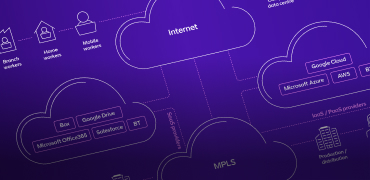Why multi-cloud networking is critical to reaching cloud maturity
Cloud migration isn’t a set destination, it’s an ongoing journey that requires you to assess, modernise, operate, and optimise continuously.

Several key factors are necessary for a company to complete a successful digital transformation.
Lots of companies fail to achieve their desired business outcomes because they focus too much on one or two areas and fail to give equal attention to areas that are sometimes less obvious. Cloud adoption or migrating applications to the cloud are one form of digital transformation.
Simply put, a digital transformation is the process of leveraging technologies to transform your business processes, culture, products, and customer experience to achieve a competitive advantage.
Where is your organisation in the journey to the cloud?
You might be just starting, or you might be in the middle of a major cloud migration. You may even have completed your cloud adoptions and are now enjoying asset-light, trouble-free IT services, in which case your focus might now be on modernising what you’ve moved. We live in an era where technologies evolve daily, so companies that fail to leverage the right ‘disruptor’ technologies may be left behind.
Whatever stage you’re at, moving to the cloud is not a set destination but rather an ongoing journey that requires you to assess, modernise, operate, and optimise continuously.
To achieve successful digital transformation, companies need to give an equal level of attention to multiple areas. Critical areas include security, compliance, connectivity, data, people, culture, business processes and change management. Although all of these are equally important for a successful digital transformation, this blog looks at the two areas that are often seen as an afterthought - connectivity and people.
Connectivity is critical to your cloud strategy
Traditional networking technology was built for another era – the era of client / server applications, in which an organisation controlled both the hosting of the applications and network connectivity. These days, in the cloud, applications can be hosted anywhere and on any platform. Network data flows can also cross many boundaries, such as those of cloud hosting providers, communications providers, and enterprise networks. Getting the connectivity right is one of the challenges to successful multi-cloud and hybrid-cloud operations.
Many companies are retaining some of their applications in their private cloud, either hosted at the provider's location or, in some instances, building out private cloud on-premises in order to take back some services from the public cloud (referred to as ‘repatriation’). Connectivity is critical when such enterprises operate applications in a hybrid model, a mix of private and public clouds.
Connectivity becomes even more critical t as the data processing gets closer to the edge and applications become more distributed over private and public clouds. Current trends around 5G and Edge devices inevitably bring the cloud closer to where data is processed, reinforcing the need for cloud centric connectivity design, right from the outset. A significant number of companies today operate in a distributed world, so knowing the differences between multi-cloud and ‘multiple’ clouds is critical when designing connectivity.
Multiple clouds refer to applications working in different cloud platforms, with limited data exchange between these two environments. In contrast, multi-cloud is where applications operate in a true hybrid model, continuously exchanging data between private and public clouds. You’ll only realise the full benefits of moving to a cloud when your cloud strategy is built on distributed applications working in a true hybrid fashion - hence multi-cloud and not multiple clouds. With a multiple clouds approach, you are treating hyperscalers like Amazon, Azure, and Google Cloud as another data centre for you to host your applications. This is not modernisation or digital transformation. This is cloud transition or ‘lift and shift’.
Having an infrastructure which is secure, always-on and connected from anywhere to any location is vital to maximising your cloud capabilities when operating in this manner. So, digital transformation at any scale will only be fully realised with the proper connectivity around you that is built for your distributed world.
People - embracing new ways of working
Although a solid architecture for your digital transformation is critical, it’s only part of the solution. Many businesses prematurely declare their cloud migration as 'mission accomplished' before full transformation has occurred. Digital transformation is a mix of two concepts. ‘Digital' – is all about the technology around connectivity, security, cloud infrastructure, data, and compliance. 'Transformation' – is how you align your people, processes, and culture to adapt in the new environment.
Having one and not the other can result in your business goals not being fully realised. A lot of companies focus primarily on the digital and technology elements, anticipating that the required cultural and business process shift will happen naturally. However, it seldom works like that. Truly adopting the cloud means working in different ways and using new skillsets. Not only in IT but across your business.
Choosing the right partner for successful digital transformation
When you choose a partner to support you with your digital transformation, you must not only select a partner who has the experience to guide you on the technology side but critically, the same provider should also have the expertise to transform your cultural and business process to operate in this modernised environment.
BT is a leader in connectivity, security, and cloud products and solutions but we also understand the criticality of the cultural transformation role. We have a dedicated team of smart transformation specialists to ensure the proper business process is created to support with your infrastructure modernisation.
Our smart transformation team can help you define the desired business outcomes of your cloud strategy, set out a clear change strategy which aligns with your cloud journey and complete a change impact assessment for people and processes. We’ll get executive and stakeholder alignment, training, and enablement in place to prepare your existing team to fit into your modernisation workstreams. We provide the right people at the right time to support your digital transformation, working together as one digital and business team to provide a solution that’s always right first time.
To find out more about how we can support you with your digital transformation journey or with any cloud services, please check out our webpage, or get in touch with your account manager.

